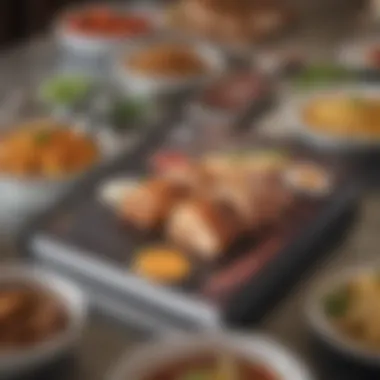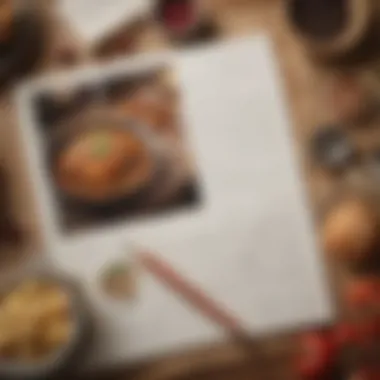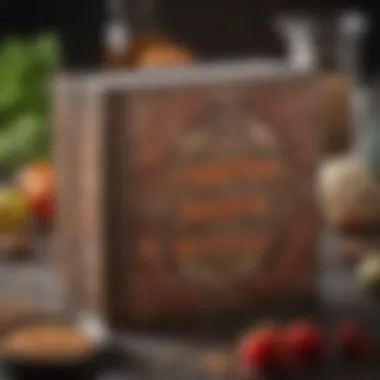Crafting Your Ultimate Recipe Card Binder


Intro
Efficient recipe management is crucial for culinary enthusiasts. Whether you are a novice in the kitchen or a seasoned chef, having your recipes neatly organized offers a sense of peace. Moreover, the binder can be a reflection of your culinary journey, filled with flavors and memories.
Recipe Overview
- Recipe Name and Description
Your recipe card book will likely be filled with unique dishes. Start with a clear name for each recipe, along with a concise description. This is where you showcase the essential elements that define the dish's character. Keep descriptions straightforward but descriptive enough to entice the cook. - Cuisine Type
Identify the type of cuisine for each recipe. This categorization allows quick access and helps you learn new cooking styles over time. Consider mainstream cuisines like Italian, Japanese, or Mexican, but do not hesitate to include fusion recipes that represent your creativity.
Ingredients List
- Detailed Ingredient Breakdown
Each recipe should include a thorough ingredients list. Detail each component, such as the quantity and specific varieties when necessary. This clarity is essential for successful execution in cooking. Being precise can prevent mishaps in flavor and texture. - Substitutions for Dietary Needs
Not all readers will have the same dietary requirements. Thus, consider including common substitutions to accommodate various needs. For instance, suggest alternatives for lactose intolerance or vegan diets. Such inclusivity ensures your binder serves a wider audience.
A well-designed recipe binder is not just about organization; it is a testament to your culinary exploration and adaptability.
The following sections will provide practical steps for gathering materials, formatting recipes, and keeping your collection efficient and appealing. By the end, you will not only have a functional recipe binder but also one that showcases your culinary passion and personal taste.
Foreword to Recipe Card Book Binders
When it comes to crafting an organized collection of culinary delights, recipe card book binders stand as a pivotal resource. This article delves into the significance of maintaining a systematic approach to recipes. Through a well-structured binder, cooking enthusiasts can access their favorite meals efficiently and preserve their culinary heritage.
The Purpose of a Recipe Card Book Binder
The primary purpose of a recipe card book binder is clear: it serves as a centralized place to store and organize recipes. A binder acts like a kitchen library, holding cherished recipes, family traditions, or new culinary finds. This method of organization not only helps in keeping the recipes clean and intact, especially when used in a bustling kitchen but also makes it easier to locate a particular recipe when needed.
Moreover, binders can be expanded as needed, allowing for continuous collection without the risk of losing any recipes. The flexibility to add or remove cards makes this system adaptable based on personal preferences.
Benefits of Organizing Recipes
Organizing recipes comes with several notable benefits. Below are two crucial aspects:
Efficiency in Meal Preparation
Efficiency plays a vital role in culinary endeavors. By organizing recipes within a binder, meal preparation becomes streamlined. When recipes are neatly categorized and easily accessible, the process is significantly expedited.
This arrangement not only saves time but also reduces stress in the kitchen. Many culinary enthusiasts find that having their go-to meals, categorized by type or cuisine, allows for quick decisions, especially during busy weeknights. This approach is popular among home cooks seeking to enhance their kitchen experience, as it minimizes the chaos often associated with meal planning.
Preservation of Culinary Heritage
Preservation of culinary heritage reflects the community and family traditions passed down through generations. A recipe card book binder can house family recipes, each card telling a story rooted in a specific cultural or familial background. This allows individuals to keep those traditions alive, sharing them with the next generation. The unique feature of this method is that it encourages storytelling. It fosters a connection to the past while adapting recipes to modern tastes. In this way, a binder is not only a practical tool but a repository of memories and heritage.
Selecting the Right Materials
Types of Binders
Standard Three-Ring Binders
Standard three-ring binders are a popular choice due to their simplicity and versatility. Their most significant characteristic is the ability to easily add or remove pages, which allows users to adapt their recipes without hassle. This feature is incredibly beneficial for those who frequently modify their collection.
The three-ring system means you can organize recipes in any order you like. However, one downside is that these binders can be bulkier than other options. Depending on your storage space, this could be a consideration. Still, they remain a reliable choice for many home cooks.
Specialty Recipe Binders
Specialty recipe binders are designed specifically for culinary enthusiasts. Their key feature is their often thematic design, which can make preserving recipes feel more personal and enjoyable. They usually come with additional organization tools such as pocket pages or built-in dividers that can be useful for categorizing recipes.
They can be more attractive than standard binders, adding a visually pleasing component to your kitchen or dining area. On the downside, these binders may come at a higher cost, and they could lack flexibility regarding the number of recipes you can organize, depending on the style.
Choosing Paper Types
Cardstock vs. Regular Paper
Choosing between cardstock and regular paper is essential for the durability and feel of your recipe cards. Cardstock is thicker and more robust, making it less prone to tear or wear over time. This characteristic is especially important if you often reference your cards while cooking, as they are less likely to crumple or smudge.
On the other hand, regular paper is lighter and can be easier to handle. It may be suitable for those who prefer a less bulky binder. However, this paper will not last as long, especially in high-use environments. Thus, if you value longevity, cardstock is generally the better option.
Water-Resistant Options
Water-resistant paper options can be a game changer in the kitchen. They offer protection against spills and splashes, which often happen during meal preparation. The key characteristic of these papers is their ability to withstand moisture, ensuring your recipes remain intact and legible.


Such options often come with a higher price tag, but their longevity and protection might justify the extra cost for many. In the end, a few water-resistant sheets in your collection can save your favorite recipes from unwanted damage.
Dividers and Labels
Customizable Dividers
Customizable dividers can enhance the organization in your recipe binder. Their foremost feature is that they can be tailored to fit your needs, like categorizing recipes by type or occasion. This contributes positively to a structured and efficient system, where finding a recipe becomes a simple task.
The downside is that creating your dividers may require additional time and effort. However, the benefits of personalization often outweigh this drawback, making them a worthwhile investment in your binder.
Labeling Systems
A labeling system helps streamline your recipe organization. An effective system will allow for quick identification of sections in your binder, which is beneficial during meal prep when time is of the essence. Labeling systems can range from simple handwritten labels to more sophisticated printed ones, depending on your preference.
The primary advantage of a good labeling system is clarity. However, it is important to ensure that labels stay in place over time, as labels falling off can disrupt your organization. Selecting durable labels can mitigate this issue.
Selecting the right materials for your recipe card book binder is crucial for a seamless cooking experience. Investing in quality materials can simplify your culinary adventures.
Designing Your Recipe Cards
Basic Layout Elements
Title and Author
The title of the recipe is crucial as it is the first point of identification. It should be clear and descriptive. The author's name can add a personal touch, highlighting family recipes or renowned chefs. This aspect contributes to the overall functionality by making it easier to navigate. A well-structured title and author line helps users locate a specific recipe quickly.
One key characteristic of a title is its conciseness; it should be informative but not overly lengthy. This is a beneficial choice in this context since titles that are too long might clutter the card. The unique feature of having the author’s name included fosters a sense of connection. However, it can be seen as less essential in informal settings.
Ingredients List
The ingredients list is the backbone of any recipe card. It helps the cook to gather all necessary items making the cooking process more efficient. A well-organized list with easily identifiable measurements ensures that there are no surprises during preparation. Furthermore, it can guide shopping decisions.
A key characteristic of the ingredients list is clarity; items should be listed in a straightforward manner. This is beneficial because it can prevent confusion. One unique feature might be to include brand suggestions for certain ingredients. However, this could limit creativity by suggesting specific products.
Preparation Steps
Preparation steps detail how to turn the ingredients into a meal, playing a vital role in the overall goal of creating delicious food. Clear instructions are necessary for successful culinary outcomes. Presenting steps in a numbered format can be effective for easy follow-through, enhancing usability.
One key characteristic is the level of detail in these instructions. This is a popular choice, as detailed steps yield better results for novice cooks. Including specific timing for each step could be a unique feature, making it easier to manage cooking times. It may lead to some clutter if the instructions are too long, affecting the card’s readability.
Incorporating Visuals
Photographs
Incorporating photographs into recipe cards can significantly enhance visual appeal. A well-taken photo of the finished dish serves as a motivator and provides a reference for presentation. This aspect encourages cooks to aim for similar results, enhancing their skills and confidence over time.
A key characteristic of photographs is their ability to engage the viewer. This makes them a beneficial addition because they can inspire use of the recipe. The unique feature of displaying mouth-watering images can invoke appetite. However, poor quality pictures could detract from the overall professional look of the recipe card.
Illustrations
Illustrations can also provide a unique touch to recipe cards. They can convey a creative flair and set a recipe apart. Illustrated cards can be particularly engaging for children, making cooking a fun activity. They can simplify complex cooking methods by providing visual cues.
The key characteristic of illustrations is their artistic value. They are beneficial as they can keep the cards visually interesting and appealing. One unique feature could be using hand-drawn icons for ingredients or steps, allowing for a personal touch. However, illustrations may not always provide the same clarity as photographs do.
Formatting Techniques
Font Choices
Choosing the right font is critical in ensuring readability. A clear and elegant font can make the card look professional while ensuring that it is easy to read. Popular fonts generally present a clean look, which is essential for quick recipe consultations.
The key characteristic of font choices is their impact on clarity. This is beneficial as well-chosen fonts can prevent misinterpretations of the recipe. A unique feature might involve using different fonts for headers and content. Though such variety is engaging, excessive font mixing could lead to visual chaos.
Color Schemes


A coherent color scheme can elevate the entire recipe card's presentation. Specific color choices can evoke particular feelings or reflect personal styles. Selecting colors that contrast well ensures the text remains readable while remaining stylish.
The key characteristic of color schemes is their influence on mood and aesthetics. This makes them a beneficial inclusion as pleasing colors can enhance the overall cooking experience. One unique feature could be using seasonal color palettes to reflect the ingredients being used. On the downside, too many colors might result in a visually overwhelming card.
Organizing Recipes Within the Binder
Organizing recipes within a binder is essential for maximizing both efficiency and accessibility. A properly organized binder allows users to locate their favorite recipes quickly, thus enhancing the overall cooking experience. With many recipes accessible at one’s fingertips, meal preparation becomes less stressful and more enjoyable. This section will cover various strategies for categorizing recipes, which serves as a backbone for effective organization in any recipe card binder.
Categorization Strategies
By Cuisine
Categorizing recipes by cuisine is a straightforward approach that many find practical and intuitive. This method groups recipes based on their cultural origins, making it easier to explore different culinary traditions. For instance, you might have sections dedicated to Italian, Mexican, or Asian recipes.
The key characteristic of this strategy is its simplicity. By having distinct sections like Italian or Chinese, users can quickly navigate through their collection. This is particularly beneficial for those who wish to try relevant dishes for themed dinners or holidays.
One unique feature of this strategy is the cultural exploration it encourages. Cooking becomes not only about eating but also about appreciating flavors from around the world. However, there can be a disadvantage if someone has overlapping cuisines. For example, a fusion recipe might not fit neatly into one section. Yet, the benefits of easy navigation often outweigh this consideration.
By Meal Type
Organizing recipes by meal type introduces a different layer of functionality. This strategy involves categorizing recipes into breakfast, lunch, dinner, and snacks. Each type serves a specific purpose and context.
A notable reason to use meal type as a categorization strategy is the convenience it provides. If someone is preparing breakfast, they can directly refer to a dedicated section without searching through unrelated recipes. This is particularly useful for families or those with diverse meal preferences throughout the day.
A unique aspect here is the ease of planning meals. For instance, if someone is hosting a brunch, they can quickly access a variety of breakfast and brunch options defined in this system. However, one disadvantage may arise for those who regularly mix meals, such as pancakes for dinner. These flexible recipes might cause confusion unless carefully labeled.
By Cooking Method
This method focuses on how recipes are prepared. Categories might include baking, grilling, frying, or slow cooking. Choosing this strategy could greatly benefit cooks who prefer specific methods or tools in their kitchen.
A prominent characteristic of organizing by cooking method is practicality. It answers the question of "what can I make with my equipment?" For example, someone who owns a slow cooker may want to explore all the options available rather than mix them with other preparation styles.
The unique feature here is the ability to concentrate on technique while exploring recipes. This can foster skill development in specific methods. Nonetheless, one potential issue could involve recipes that utilize multiple cooking techniques, potentially leading to misplaced cards. Yet, these drawbacks are manageable when the organization system is adhered to.
Creating a Table of Contents
Having a table of contents can significantly enhance the efficiency of using the binder. It acts as a guide for navigating the different sections, making it easier to locate recipes. When creating a table of contents, ensure that it's updated regularly. Each time you add or remove recipes, adjustments will support ongoing accessibility.
In summary, organizing recipes effectively within the binder is fundamental to creating a cohesive culinary experience. Whether you choose to categorize by cuisine, meal type, or cooking method, it is vital to find a strategy that resonates with your cooking habits. Each method has its attributes and drawbacks, which can be managed with thoughtful implementation.
Maintaining and Updating Your Binder
Maintaining and updating your recipe card binder is a crucial aspect of managing your culinary collection. As recipes evolve, especially with dietary preferences changing or culinary trends emerging, keeping your binder relevant and efficient is necessary. An organized and regularly updated binder can save you time and help preserve favorite dishes that may otherwise be forgotten. This will promote an effective cooking process and ensure you can always find what you need.
Regular Reviews
Frequency of Updates
Regular reviews of your recipe binder ensure you always have the most relevant and enjoyable recipes at your fingertips. Depending on your cooking habits, a frequent update may be a good fit, like every month or season. Updates not only help in refreshing your selection but provide an opportunity to integrate new tastes into your collection. Keeping a steady schedule for these reviews helps maintain discipline in updating the recipes you love. A specific update frequency allows you to evaluate which recipes remain favorites and which to retire.
- Key Characteristic: Regular review time frames can guide you in becoming more efficient in meal planning.
- Unique Feature: Having a set schedule creates a routine that is easy to follow. This repeated practice ensures your collection remains dynamic, enhancing your overall cooking experience. The disadvantage might be the possibility of feeling overwhelmed if the collection grows significantly, which can require more time during reviews.
Removing Outdated Recipes
Removing outdated recipes is essential in curating your collection. When recipes become less appealing due to changes in taste or dietary needs, taking them out keeps your binder focused. Recipes without frequent use can clutter the collection and make it harder to find the dishes you truly enjoy. Evaluating how often you cook certain recipes can illuminate ones that no longer serve your needs.
- Key Characteristic: This practice promotes a streamlined cooking experience, freeing you from unnecessary choices.
- Unique Feature: You could consider a "trial period" for new recipes. If a new dish is not made within six months, it may be removed. This allows for exploration without the commitment of permanent addition. The downside might include the risk of discarding a recipe that could have been a hidden gem.
Adding New Recipes
Methods for Incorporating New Cards
Incorporating new recipe cards is a continual process in keeping the culinary adventure alive. There are many ways to introduce fresh recipes to your binder. Whether collecting from various sources or experimenting in the kitchen, every new addition broadens your horizons. Creating an easy method, such as a specific page for new recipes before their evaluation, allows for adjustments without cluttering the main sections.


- Key Characteristic: This method ensures that your binder evolves alongside your cooking capabilities.
- Unique Feature: View new recipes as trial cards; they can only stay if you have made them a certain number of times, fostering discipline in your selections. A possible disadvantage could be the extra effort required during the initial review process, but this ultimately leads to a more refined collection.
Digital vs. Physical Recipes
The choice between digital and physical recipes contributes to how you maintain your binder. Digital recipes can be quickly edited and updated, providing flexibility. They are often more accessible, if you are comfortable with technology. On the other hand, physical recipes offer the tactile satisfaction of handling cards and can be desirable for those who enjoy a hands-on approach. This personal preference can guide your method of preserving recipes.
- Key Characteristic: Each has unique benefits, where digital offers ease and speed, while physical connects more to nostalgia and simplicity.
- Unique Feature: Consider blending both methods. Utilize digital tools for easily changing recipes and print favorites to keep in your binder. This approach allows versatility but can lead to complications if not managed well.
To effectively maintain your recipe card binder, regular reviews, removing outdated recipes, and incorporating new cards are essential. Along with choosing the right format, you establish a supportive environment for your culinary passions.
Personalizing Your Recipe Card Book
Personalizing your recipe card book is an essential part of creating a collection that reflects your unique culinary style. This process enhances not only the aesthetic appeal of your binder but also serves functional purposes. A personalized binder can lead to a more enjoyable cooking experience. When you can see your personality in your binder, it encourages more use, exploration, and experimentation in the kitchen.
One of the most important benefits of personalization is the emotional connection you create with your recipes. Using design elements that resonate with you makes it more likely that you'll engage with the contents of your binder. Personalization also helps with organization. Customized labels and categories aid in finding recipes quickly. Additionally, personal notes encourage you to make modifications and adapt recipes to suit your preferences.
Key elements to consider include custom covers and spines, and incorporating personal notes into your recipes. Each of these elements plays a critical role in shaping your recipe card book to match your culinary journey.
Custom Covers and Spines
Design Ideas
The design of your custom covers and spines is a significant first impression for your recipe card book. This can range from simple designs to more elaborate graphical representations of your cooking style. You might choose colors and images that inspire you. A well-designed cover can make your binder a beautiful piece worth displaying in your kitchen.
A key characteristic of thoughtful cover design is its ability to reflect personal style. It might incorporate motifs that are special to you, like food illustrations or family photographs. Custom covers are also a popular choice because they set a tone. They signify that the recipes within are not just any recipes, but ones that are cherished.
A unique feature of designing covers is using materials that match your kitchen aesthetics. Laminated options are easy to clean and durable. However, they may lack the warmth of fabric covers, which can be inviting but require more care. Striking the right balance between visual appeal and practicality is essential.
Durability Considerations
Durability is crucial when it comes to custom covers and spines. You want your recipe binder to withstand usage over time, especially in a busy kitchen. Durable materials such as heavy cardstock or synthetic covers provide protection against spills and wear.
The key characteristic of durability is long-lasting quality. It ensures your beautiful design does not succumb to daily mishaps. This is a beneficial choice for your binder, as it maintains its appearance and function, allowing you to focus on cooking rather than replacing components.
Another unique feature to explore is the option of adding reinforced edges. These can enhance longevity. However, the trade-off might be a slightly bulkier look. Choosing the right materials and reinforcement options ensures your binder will last while remaining visually pleasing.
Incorporating Personal Notes
Space for Annotations
Having space for annotations in your recipe cards adds a layer of personalization that makes your cooking experience deeper. This allows you to jot down notes, tips, or reminders based on your cooking experiences. When trying a new recipe, notes can be invaluable for recording adjustments you made or what worked well.
The key characteristic here is functionality. Space for annotations invites you to actively engage with recipes rather than just follow them. This active participation makes cooking more enjoyable and tailored to your tastes. Additional spaces can be designed beside ingredients or preparation steps to optimize usability.
A unique feature of this method is that it lets each recipe evolve over time. The advantages include creating a document that has history and context specific to your cooking journey. However, a disadvantage may arise if the notes become too cluttered, making the original recipe harder to read.
Recipe Modifications
Recipe modifications are integral for making a dish truly yours. By having dedicated sections in your recipe book for modifications, you can document changes that improve a dish or make it your own. This personalized note serves as a guide for future attempts and allows for trial and error.
The key characteristic of this approach is creativity in cooking. It encourages you to explore variations and substitutions which can lead to discovering new flavor combinations. This can be a popular choice as it fosters innovation in the kitchen and keeps you engaged with your culinary repertoire.
A unique feature of incorporating modifications is that you can add personal touches, like dietary restrictions or new ingredients. However, it can be challenging to translate specific changes back to the original recipe. Careful annotation can mitigate this, enabling you to enjoy flexibility while maintaining a connection to the original dish.
Finale
The essence of crafting a recipe card book binder lies in its ability to streamline your culinary practices. This methodical approach to organizing recipes can unlock a new level of efficiency and creativity for both novice cooks and experienced chefs.
Reflecting on the Benefits
Having a dedicated recipe card binder allows for several key advantages. First, it enhances accessibility. When recipes are organized systematically, you can quickly locate what you need, saving precious time in the kitchen. Next, it fosters creativity. A well-organized binder can serve as a source of inspiration, encouraging you to try new dishes or revisit favorites that have been lost in the chaos.
Additionally, there is a tangible sense of accomplishment in maintaining a collection of recipes. This personalized touch can deepen your connection to food and cooking. A binder can serve as a family heirloom, preserving recipes that tell a story, linking generations through shared culinary experiences.
"Organizing recipes not only simplifies meal preparation, it captures personal histories that enhance our dining experience."
Encouragement to Start the Process
Don’t hesitate to begin assembling your recipe card book binder. Choose materials and design elements that resonate with your style. Assembling the foundation, though possibly time-consuming, offers a productivity reward that yields lasting satisfaction. Start with a few of your favorite recipes. Over time, you will notice how it becomes second nature to add new cards and update existing ones.
Every recipe has the potential to evoke memories, whether it is a dish prepared for a special occasion or a family favorite. Allowing yourself to create a dedicated space for these recipes is a step toward cherishing those moments further. Ultimately, your recipe card book binder is not just a collection of cards; it is a reflective journey that enhances your culinary experience.















